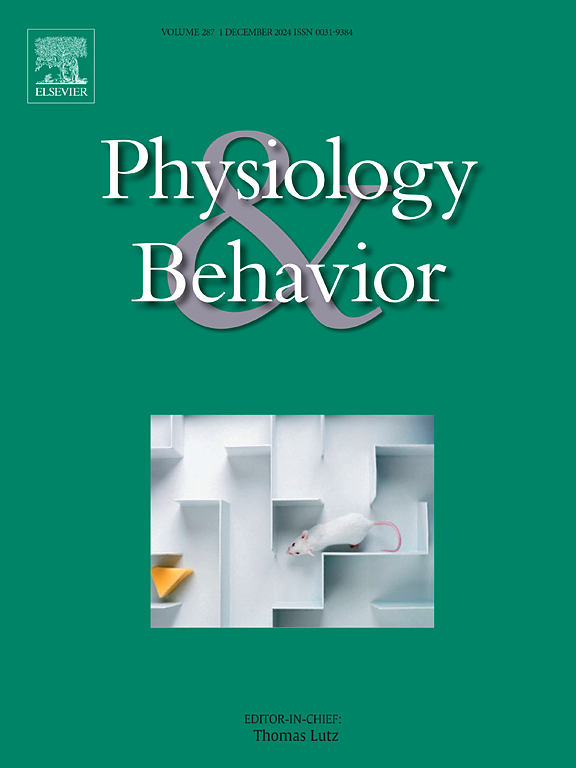Taste and oral somatosensation: Role of PTC bitter sensitivity, gender, and age
IF 2.4
3区 医学
Q2 BEHAVIORAL SCIENCES
引用次数: 0
Abstract
Sensitivity to the bitterness of phenylthiocarbamide (PTC) is considered to be linked to general taste perception, which is higher in women, and exhibits a slight decrease with age. Additionally, PTC sensitivity may contribute to somatosensory perception of spiciness and astringency. However, controversial data have been reported. This study investigates the relation between PTC perception, age, and gender on taste and somatosensory sensitivity using the Seven-iTT. A total of 200 healthy participants were classified based on their PTC perception, and subjects underwent an extended version of Seven-iTT to identify and rate the intensity of twelve stimuli. Results indicated that individuals classified as Tasters (T) exhibited higher taste scores compared to Non-Tasters (NT) for PTC, with age serving as a significant factor (p ≤ 0.009). Women outperformed men only among NT (p = 0.019). Older T demonstrated higher taste sensitivity than NT, suggesting that PTC status might act as a protective factor of gustatory function in aging. While PTC taster status significantly affected the intensity of sweet, salty, and bitter sensations (p ≤ 0.032), it had minimal impact on the intensity of somatosensory sensations (capsaicin and tannins). The combined use of Seven-iTT and the investigation of PTC status show promise for applications in research and clinical practice, offering a comprehensive approach to understanding taste perception and its implications for diet, nutrition, and aging.
味觉和口腔体感:PTC 苦味敏感性、性别和年龄的作用。
对苯硫代甲酰胺(PTC)苦味的敏感性被认为与一般味觉感知有关,女性的味觉感知较高,并随着年龄的增长而略有下降。此外,对 PTC 的敏感性可能有助于对辣味和涩味的体感。然而,有报道称这些数据存在争议。本研究使用 Seven-iTT 研究了 PTC 感知、年龄和性别与味觉和体感敏感度之间的关系。共对 200 名健康参与者进行了 PTC 感知分类,受试者接受了扩展版的 Seven-iTT 测试,对 12 种刺激的强度进行识别和评分。结果表明,与非品尝者(NT)相比,品尝者(T)的 PTC 味觉得分更高,年龄是一个重要因素(p ≤ 0.009)。只有在非品尝者中,女性的表现优于男性(p = 0.019)。老年 T 型人的味觉灵敏度高于 NT 型人,这表明 PTC 状态可能是衰老过程中味觉功能的一个保护因素。虽然 PTC 味觉对甜、咸和苦味的强度有明显影响(p ≤ 0.032),但对体感(辣椒素和单宁酸)的强度影响甚微。将 Seven-iTT 和 PTC 状态调查结合使用,有望应用于研究和临床实践,为了解味觉及其对饮食、营养和衰老的影响提供了一种全面的方法。
本文章由计算机程序翻译,如有差异,请以英文原文为准。
求助全文
约1分钟内获得全文
求助全文
来源期刊

Physiology & Behavior
医学-行为科学
CiteScore
5.70
自引率
3.40%
发文量
274
审稿时长
47 days
期刊介绍:
Physiology & Behavior is aimed at the causal physiological mechanisms of behavior and its modulation by environmental factors. The journal invites original reports in the broad area of behavioral and cognitive neuroscience, in which at least one variable is physiological and the primary emphasis and theoretical context are behavioral. The range of subjects includes behavioral neuroendocrinology, psychoneuroimmunology, learning and memory, ingestion, social behavior, and studies related to the mechanisms of psychopathology. Contemporary reviews and theoretical articles are welcomed and the Editors invite such proposals from interested authors.
 求助内容:
求助内容: 应助结果提醒方式:
应助结果提醒方式:


